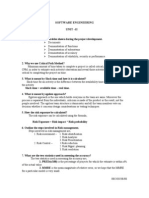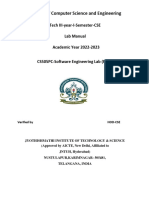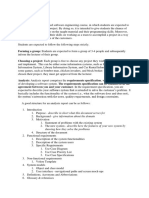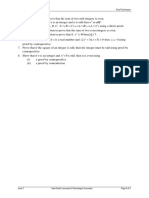Assignment Question SDM0324
Uploaded by
nastaranesmaeilzadeh2Assignment Question SDM0324
Uploaded by
nastaranesmaeilzadeh2CT046-3-2 SDM – SYSTEMS DEVELOPMENT METHODS APU DEGREE – LEVEL 2
ASIA PACIFIC UNIVERSITY
CT046-3-2 SDM – SYSTEMS DEVELOPMENT METHODS - DEGREE – LEVEL 2
IN-COURSE ASSIGNMENT
LEARNING OUTCOMES:
Construct the system modelling using appropriate tools and techniques (C3, PLO2)
Demonstrate appropriate analysis, design and implementation techniques through a simple
prototype (A3,PLO4)
CASE STUDY:
CyberNex Solutions: Software Development Management System
CyberNex Solutions is a software company offering cutting-edge software development services. As
the company grows, the leadership sees the opportunity to enhance its services through the adoption of
advanced technology. To optimize operations and prepare for future expansion, the management has
engaged your team as IT consultants. The task is to assist CyberNex Solutions in creating a robust
information system that can support the company's operations and accommodate its growth. During
the initial meeting the management provided background information and outlined the current
situation.
CyberNex Solutions employs a diverse team including software developers, project managers, quality
assurance professionals and more. The company also collaborates with external vendors providing
services such as cloud infrastructure, development tools and testing services. Vendors can register
through a new system specifying their services and pricing. Partnership agreements with vendors
require thorough verification before they are integrated into the software development process.
Clients can initiate a software development project through the system by creating an account and
logging in. The client specifies the type of software solution needed (e.g., web applications, mobile
apps, custom software, etc.), project timelines, desired features and any additional requirements. The
system generates a project plan and the client is required to approve the proposal within a specified
period. Failure to do so results in automatic cancellation of the original request. Upon client approval
and initial payment, the system generates a project confirmation.
For each confirmed project the company assigns a dedicated team that includes software developers,
project managers and quality assurance specialists based on the project's scope and requirements.
Clients can schedule meetings with the project team through the system for regular updates and
discussions during the development phase.
To build trust and maintain a positive reputation, clients have the option to provide feedback after the
completion of their software project. Additionally, a service fee is charged to vendors for each
successfully completed project. At the end of each month, CyberNex Solutions calculates the
payments owed to each vendor based on agreed service rates, sending them statements and cheques.
Software developers, project managers and administrators have access to the system for managing
projects, teams, scheduling, payments and generating various business reports. The management has
allocated a budget of RM100,000 for the project with an estimated timeline of FIVE(5) months for
ASIA PACIFIC UNIVERSITY 1 112023
CT046-3-2 SDM – SYSTEMS DEVELOPMENT METHODS APU DEGREE – LEVEL 2
completion. The objective is to plan, analyze, design, and develop a prototype that aligns with
CyberNex Solutions requirements and objectives in software development management.
*Note: You are not only limited to the above requirements. Any other relevant requirements to ease
the process of managing the CyberNex operations can be added if you think they are viable.
TASKS:
Work with 6 (SIX) students in a group. Assume that you are a group of software development
consultants, hired to advise CyberNex on efficient development approaches for their project.
You are required to document the following:
1. Project Planning (Group Task)
1.1. Introduction - Provide a brief introduction to CyberNex company including its stakeholders,
users, current business process, etc. (paragraph)
1.2. Problem Statements – Discuss the existing business problems of the CyberNex company.
1.3. Suggested System – Briefly explain the suggested system that you would propose for the
above project. Include a conceptual diagram to show your initial idea of the new system (you
may use any diagram such as a Rich Picture, Context Diagram, etc.).
1.4. Scopes, and Objectives – Define the Scopes and Objectives for the CyberNex project.
1.5. Project Scheduling - Create a project schedule (such as a Gantt Chart) according to one of
the system development methodologies that you have suggested in Part 2.2 below. Clearly
show the duration, tasks (and sub-tasks), and predecessor (parallel, sequential, iterative, if
any) recommended for the project.
2. Agile Principles and IS Methodologies (Individual Task)
2.1. Agile Principles - In the initial stage, your team has decided that Agile Methods could be
beneficial to be applied to the CyberNex project. Each student is to discuss in detail TWO
(2) Agile Principles that you would implement to make your projects more agile. Explain the
strategies that you would take to implement them.
Group members are to suggest and discuss different Agile Principles with each other.
2.2. IS Methodologies – A system development methodology refers to the steps that are used to
structure, plan, and control the process of developing an information system. Each student is
to suggest and discuss in detail ONE (1) of the IS methodologies. Explain how you would
carry out your CyberNex project according to the methodology.
Members are to suggest and discuss different IS methodologies with each other.
Your answers in a group should include methodologies from Structured Methodology,
Agile-based Methodology including Process Oriented Methodology, and People-Oriented
Methodology.
ASIA PACIFIC UNIVERSITY 2 112023
CT046-3-2 SDM – SYSTEMS DEVELOPMENT METHODS APU DEGREE – LEVEL 2
3. System Analysis (Group Task)
Assume that you have collected ample data and information for the CyberNex project during the
‘Requirement Elicitation’ stage. Describe in detail TWO (2) system analysis methods that you
would use to analyze data gathered from your investigations. Justify your selections.
4. Design (Individual Task)
Design often comprises the modelling of the system. Each student is to discuss ONE (1)
modelling technique that you would adopt for the CyberNex project and is relevant to your
selected methodology (in Task 2.2). Then, based on your selected modelling technique, each
student is also required to create ONE (1) diagram for the CyberNex project.
Group members are to discuss different modelling techniques and create different
diagrams from each other e.g., Use Case diagram, State Machine Diagram, Class
Diagram, etc.
5. Implementation and Deployment (Group Task)
5.1. Construction – List and explain the functions and purpose of the major software (and
tools) that you would consider in the construction of the new system for the CyberNex
company.
List of software Purpose
Phyton
Figma
5.2. Proof of Concept - Create a ‘throw-away’ prototype for the CyberNex system (a simple
form of a prototype that is for demonstration purposes).
5.3. Testing - Discuss in detail any TWO (2) testing methods that are suitable for the CyberNex
system. Explain in detail how these tests will be carried out for your system.
5.4. System Deployment – Compare any TWO (2) types of ‘system change over method(s)’
available. Based on your comparison, choose only ONE (1) change-over method that is best
suited for the CyberNex project. Explain in detail how and why the selected method is carried
out.
ASSIGNMENT DELIVERABLES AND CONDITIONS:
Final Documentation must be word-processed; submission is done online through Moodle. A
maximum of 10,000 words in length is recommended.
Note: Please exclude the cover page, table of contents, workload matrix, and references pages
when you do a word count. Make sure to only count words/answers to the questions.
ASIA PACIFIC UNIVERSITY 3 112023
CT046-3-2 SDM – SYSTEMS DEVELOPMENT METHODS APU DEGREE – LEVEL 2
Include a ‘Workload Matrix’ (to be given by the lecturer), indicating the contribution of each
individual for each required component (shown in percentage), and should be signed off by each
team member, attached to the APPENDIX part of the final document.
Citation of facts is mandatory. Obtain your facts from credible sources in references/bibliography.
Avoid ‘dumping of data’. Instead, the facts that you discuss should be made relevant to your
case/project. Kindly use the 7th Edition of APA referencing style.
It is acceptable for the discrete activities of this assignment to be undertaken by individual group
members. However, all group members must understand the presentation in its entirety. At the end
of the submission, your group might be asked a series of questions to explore your understanding
and analysis of the given problem.
Late submissions will not be assessed unless extenuating circumstances are upheld.
Acceptable Turnitin similarity results in a maximum of 10%.
Font setup: use 1.5 spacing, justify paragraph alignment, 12-pt font size, Times New Roman.
Page setup: Margin for top, left, right, and bottom = 2.54 cm. A4 page size. Portrait page
orientation.
Submission Date
Submission Date
Components
and Time
1. Project Planning
20th May 2024
2. Agile Principles and IS Methodologies Monday
3. System Analysis Marking
4. System Design Before 11:59 PM Criteria
5. Implementation and Deployment
Components Allocated Marks
Project Planning (Group Task) 10
Agile Principles and IS Methodologies (Individual Task) 20
System Analysis (Group Task) 10
System Design (Individual Task) 25
Implementation and Deployment (Group Task) 30
Documentation & Report (Layout, writing, formatting,
5
referencing, etc.) (Group Task)
Total 100
ASIA PACIFIC UNIVERSITY 4 112023
CT046-3-2 SDM – SYSTEMS DEVELOPMENT METHODS APU DEGREE – LEVEL 2
Performance Criteria
Distinction (75% and above)
This grade will be assigned to work where the documentation is complete and describes in detail, with
little or no errors, the following components: Introduction, Agile Principles, System Development
Methodology, System Design, and Implementation. To obtain this grade, the candidate’s assignment
should show all techniques of process applied with little or no errors. All deliverables of the individual
component should be coherent with detailed descriptions to explain the diagrams. Overall
documentation standards for both the group project as well as the individual assignment should be of
excellent quality. To obtain a grade at this level, individuals should be able to address all issues
concerning not only their component of the module but also those of the other group members.
Individual’s contribution to the project, at this level, should be more than 75% and overall peer
evaluation should indicate excellent standards.
Credit (56% – 69%)
This grade will be assigned to work where the documentation is complete and describes briefly, with
some errors, the following components: Introduction, Agile Principles, System Development
Methodology, System Design, and Implementation. To obtain this grade, the candidate’s assignment
should show all techniques of the methodology applied but some errors. All deliverables of the
individual component should be coherent with detailed descriptions to explain the diagrams. Overall
documentation standards for both the group project as well as the individual assignment should be of
excellent quality. To obtain a grade at this level, individuals should be able to address most issues
concerning not only their component of the module but also those of the other group members.
Individual’s contribution to the project, at this level, should be more than 65% and overall peer
evaluation should indicate excellent standards.
Pass (40% - 55%)
This grade will be assigned to work where, most of the basic requirements of the documentation listed
above, such as Introduction, Agile Principles, System Development Methodology, System Design, and
Implementation are of an adequate standard which is evident in the softcopy of the documentation.
The physical design of the system in terms of the interactive screen design and report maps adequately
against the logical design presented in the documentation. The documentation should be of adequate
standard in terms of language, layout, and flow. Some accurate, relevant, and up-to-date referencing
was visible. Group presentation the team should have adequate visual aids with relevant information
presented and adequate coordination among group members. Individuals should display an adequate
level of professionalism and project knowledge. Peer-to-peer evaluation of an individual’s
contribution should be adequate.
Fail (Below 40%)
This grade will be assigned to work where, most of the basic requirements of the documentation listed
above, such as Introduction, Agile Principles, System Development Methodology, System Design, and
Implementation are of a poor standard which is evident in the softcopy of the documentation. The
physical design of the system in terms of the interactive screen design and report shows little or no
mapping/linking with the logical design presented in the documentation. The documentation is of poor
standard in terms of language, layout, and flow. Minimal or no referencing was done. The group
presentation of the team has poor visual aids with irrelevant information presented and poor
coordination among group members. Individuals display on average a poor level of professionalism
and project knowledge. Peer-to-peer evaluation of an individual’s contribution is poor.
ASIA PACIFIC UNIVERSITY 5 112023
You might also like
- Hubspot and Motion Ai: Chatbot-Enabled CRM: Akanksha Jaiswal Sahil JangamNo ratings yetHubspot and Motion Ai: Chatbot-Enabled CRM: Akanksha Jaiswal Sahil Jangam21 pages
- 04-DDD.Assignment brief 1 2018 - 2019-đã chuyển đổi PDFNo ratings yet04-DDD.Assignment brief 1 2018 - 2019-đã chuyển đổi PDF4 pages
- Practical: 1: Dr. Subhash Technical CampusNo ratings yetPractical: 1: Dr. Subhash Technical Campus58 pages
- Itec54-System-Integration-And-Architecture-1 - SDLCNo ratings yetItec54-System-Integration-And-Architecture-1 - SDLC6 pages
- Chapter 2 System Analysis and Design - SDLC Phases IntroductionNo ratings yetChapter 2 System Analysis and Design - SDLC Phases Introduction5 pages
- FUNDAMENTALS OF SYSTEMS ANALYSIS AND DESIGNNo ratings yetFUNDAMENTALS OF SYSTEMS ANALYSIS AND DESIGN43 pages
- 02 SDM Ct04632 Project Specification Mts Case StudyNo ratings yet02 SDM Ct04632 Project Specification Mts Case Study4 pages
- Comparison Between Traditional Approach and Object-Oriented Approach in Software Engineering DevelopmentNo ratings yetComparison Between Traditional Approach and Object-Oriented Approach in Software Engineering Development7 pages
- Systems Development: Phases, Tools, and TechniquesNo ratings yetSystems Development: Phases, Tools, and Techniques59 pages
- WEEK 4 Traditional vs Object Oriented ApproachNo ratings yetWEEK 4 Traditional vs Object Oriented Approach6 pages
- System Development Life Cycle: Phases of SDLCNo ratings yetSystem Development Life Cycle: Phases of SDLC6 pages
- Introduction To Systems Analysis and DesignNo ratings yetIntroduction To Systems Analysis and Design24 pages
- Week 3 Systems Development Life Cycle 2 (1)No ratings yetWeek 3 Systems Development Life Cycle 2 (1)8 pages
- Using Scrum in A Quarter-Length Undergraduate Software Engineering CourseNo ratings yetUsing Scrum in A Quarter-Length Undergraduate Software Engineering Course11 pages
- Specialized Project Models and Agile Process DevelopmentNo ratings yetSpecialized Project Models and Agile Process Development8 pages
- Lab Manual Software Engineering: Mr. Pradeep Yadav Mr. C.P. BhargavaNo ratings yetLab Manual Software Engineering: Mr. Pradeep Yadav Mr. C.P. Bhargava71 pages
- Implementing and Upgrading Clinical Information SystemsNo ratings yetImplementing and Upgrading Clinical Information Systems35 pages
- Software Testing Interview Questions You'll Most Likely Be AskedFrom EverandSoftware Testing Interview Questions You'll Most Likely Be AskedNo ratings yet
- Normalization Step by Step (Lecturer Version)No ratings yetNormalization Step by Step (Lecturer Version)6 pages
- 3 Types of Relationship Between EntitiesNo ratings yet3 Types of Relationship Between Entities9 pages
- Simplex 4190 Truesite Workstation (TSW) Software Upgrade InstructionsNo ratings yetSimplex 4190 Truesite Workstation (TSW) Software Upgrade Instructions24 pages
- DS-2CD6924G0-IHS NFC Datasheet V5.5.84 20220114No ratings yetDS-2CD6924G0-IHS NFC Datasheet V5.5.84 202201146 pages
- Belsee Aftermarket Tesla Style Screen Android 11No ratings yetBelsee Aftermarket Tesla Style Screen Android 112 pages
- Jabra Elite 85h User Manual - EN - English - RevCNo ratings yetJabra Elite 85h User Manual - EN - English - RevC25 pages
- Scrolling Text On LCD of AT89S52 Development BoardNo ratings yetScrolling Text On LCD of AT89S52 Development Board9 pages
- Data Modeling Using The Entity-Relationship (ER) ModelNo ratings yetData Modeling Using The Entity-Relationship (ER) Model35 pages
- Syncbox/N2X: Converts NTP or Ieee-1588 To Irig, 10Mhz, PPS, Dcf77 and Serial Time TelegramsNo ratings yetSyncbox/N2X: Converts NTP or Ieee-1588 To Irig, 10Mhz, PPS, Dcf77 and Serial Time Telegrams5 pages
- Analog Style VU Meter On OLED Display - Arduino CompatibleNo ratings yetAnalog Style VU Meter On OLED Display - Arduino Compatible5 pages
- Soft Computing Practical Teacher ManualNo ratings yetSoft Computing Practical Teacher Manual87 pages
- Travel Assist: FYP Proposal Document TemplateNo ratings yetTravel Assist: FYP Proposal Document Template17 pages
- Cambridge International AS & A Level: Computer Science 9618/41No ratings yetCambridge International AS & A Level: Computer Science 9618/4112 pages
- Setting Up (53M) : ABAP Core Data Services Extraction For SAP Data IntelligenceNo ratings yetSetting Up (53M) : ABAP Core Data Services Extraction For SAP Data Intelligence16 pages
- ICT11 Course Outline Introduction To CSSNo ratings yetICT11 Course Outline Introduction To CSS2 pages
- Design of High Speed Ddr3 Sdram ControllerNo ratings yetDesign of High Speed Ddr3 Sdram Controller96 pages
- Hubspot and Motion Ai: Chatbot-Enabled CRM: Akanksha Jaiswal Sahil JangamHubspot and Motion Ai: Chatbot-Enabled CRM: Akanksha Jaiswal Sahil Jangam
- 04-DDD.Assignment brief 1 2018 - 2019-đã chuyển đổi PDF04-DDD.Assignment brief 1 2018 - 2019-đã chuyển đổi PDF
- Itec54-System-Integration-And-Architecture-1 - SDLCItec54-System-Integration-And-Architecture-1 - SDLC
- Chapter 2 System Analysis and Design - SDLC Phases IntroductionChapter 2 System Analysis and Design - SDLC Phases Introduction
- 02 SDM Ct04632 Project Specification Mts Case Study02 SDM Ct04632 Project Specification Mts Case Study
- Comparison Between Traditional Approach and Object-Oriented Approach in Software Engineering DevelopmentComparison Between Traditional Approach and Object-Oriented Approach in Software Engineering Development
- Systems Development: Phases, Tools, and TechniquesSystems Development: Phases, Tools, and Techniques
- Using Scrum in A Quarter-Length Undergraduate Software Engineering CourseUsing Scrum in A Quarter-Length Undergraduate Software Engineering Course
- Specialized Project Models and Agile Process DevelopmentSpecialized Project Models and Agile Process Development
- Lab Manual Software Engineering: Mr. Pradeep Yadav Mr. C.P. BhargavaLab Manual Software Engineering: Mr. Pradeep Yadav Mr. C.P. Bhargava
- Implementing and Upgrading Clinical Information SystemsImplementing and Upgrading Clinical Information Systems
- Software Testing Interview Questions You'll Most Likely Be AskedFrom EverandSoftware Testing Interview Questions You'll Most Likely Be Asked
- Simplex 4190 Truesite Workstation (TSW) Software Upgrade InstructionsSimplex 4190 Truesite Workstation (TSW) Software Upgrade Instructions
- Scrolling Text On LCD of AT89S52 Development BoardScrolling Text On LCD of AT89S52 Development Board
- Data Modeling Using The Entity-Relationship (ER) ModelData Modeling Using The Entity-Relationship (ER) Model
- Syncbox/N2X: Converts NTP or Ieee-1588 To Irig, 10Mhz, PPS, Dcf77 and Serial Time TelegramsSyncbox/N2X: Converts NTP or Ieee-1588 To Irig, 10Mhz, PPS, Dcf77 and Serial Time Telegrams
- Analog Style VU Meter On OLED Display - Arduino CompatibleAnalog Style VU Meter On OLED Display - Arduino Compatible
- Cambridge International AS & A Level: Computer Science 9618/41Cambridge International AS & A Level: Computer Science 9618/41
- Setting Up (53M) : ABAP Core Data Services Extraction For SAP Data IntelligenceSetting Up (53M) : ABAP Core Data Services Extraction For SAP Data Intelligence














































































































